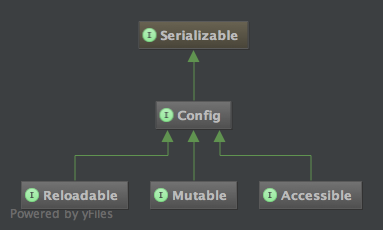Accessible and Mutable
By default, object created by OWNER are immutable and promote information hiding.
This means that once the Config object is created its properties cannot be modified, and cannot be accessed in any other way than using the methods that are properties mapping methods.
Those limitations are imposed by design, but sometime users may find this problematic. So here they come in the play the interfaces Mutable and Accessible.
This is the hierarchy of the Mutable and Accessible interfaces:

The Mutable interface
The Mutable interface allows the developer for runtime modifications of the properties contained in the Config object.
Example:
interface MyConfig extends Mutable {
@DefaultValue("18")
public Integer minAge();
public Integer maxAge();
}
MyConfig cfg = ConfigFactory.create(MyConfig.class);
// this comes from the @DefaultValue
assertEquals(Integer.valueOf(18), cfg.minAge());
// now we change the minAge to 21 using setProperty
String oldValue = cfg.setProperty("minAge", "21");
assertEquals("18", oldValue); // the old value was 18
assertEquals(Integer.valueOf(21), cfg.minAge()); // now is 21
// now we remove the minAge property
oldValue = cfg.removeProperty("minAge");
assertEquals("21", oldValue); // the old value is 21
assertNull(cfg.minAge()); // now is null
In the above example we saw setProperty and removeProperty in action, but the Mutable interface adds even more
methods like clear(), load(InputStream) and load(Reader), and it should allow you to achieve complete write access
to the properties contained inside a Config object.
The Accessible interface
As the Mutable interface allows for write access to the properties contained inside a Config object, the Accessible interface allows for read access.
Example:
interface MyConfig extends Accessible {
@DefaultValue("Bohemian Rapsody - Queen")
String favoriteSong();
@Key("salutation.text")
@DefaultValue("Good Morning")
String salutation();
}
MyConfig cfg = ConfigFactory.create(MyConfig.class);
assertEquals("Good Morning", cfg.getProperty("salutation.text"));
// print all properties to a PrintWriter
cfg.list(System.out);
// saves properties to an OutputStream
File tmp = File.createTempFile("owner-", ".tmp");
cfg.store(new FileOutputStream(tmp), "no comments");
As you can see, Accessible is not limited to the getProperty() method, but you can also use this
interface to list() or store() the properties.
